Leadership Style and Capabilities of Tracy Moyer
VerifiedAdded on 2021/04/21
|7
|1596
|38
AI Summary
The assignment provides an in-depth analysis of the leadership style and capabilities of Tracy Moyer, the director of Cutis Care LLC Southwest Region. It highlights her use of transformational leadership, which encourages employees to perform and achieve core organizational objectives. The document also explores her approach to motivating staff, including introducing performance reviews, which was a successful organizational outcome. Furthermore, it examines her strategy for developing a leadership mentor program to build a responsible and confident workforce.
Contribute Materials
Your contribution can guide someone’s learning journey. Share your
documents today.
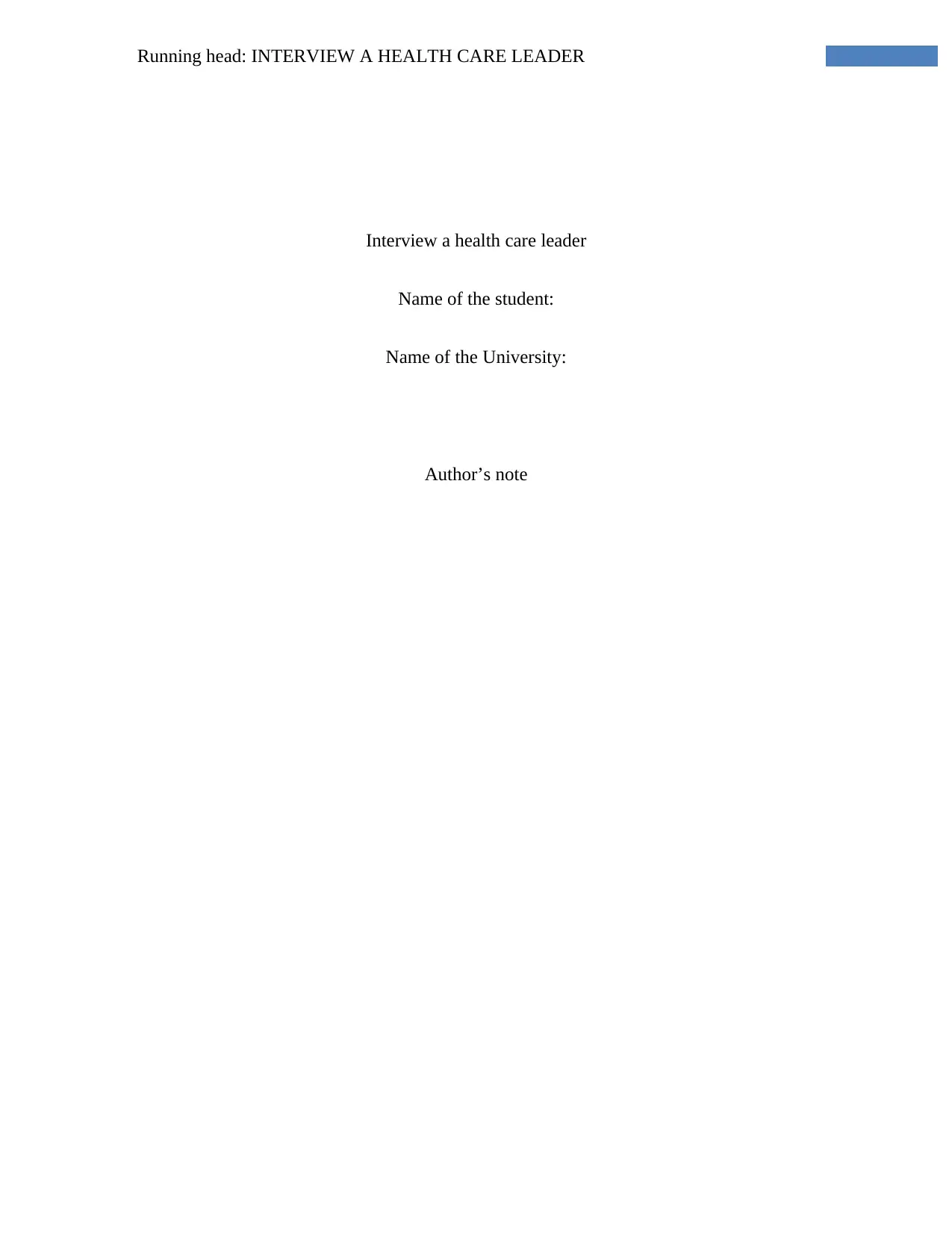
Running head: INTERVIEW A HEALTH CARE LEADER
Interview a health care leader
Name of the student:
Name of the University:
Author’s note
Interview a health care leader
Name of the student:
Name of the University:
Author’s note
Secure Best Marks with AI Grader
Need help grading? Try our AI Grader for instant feedback on your assignments.
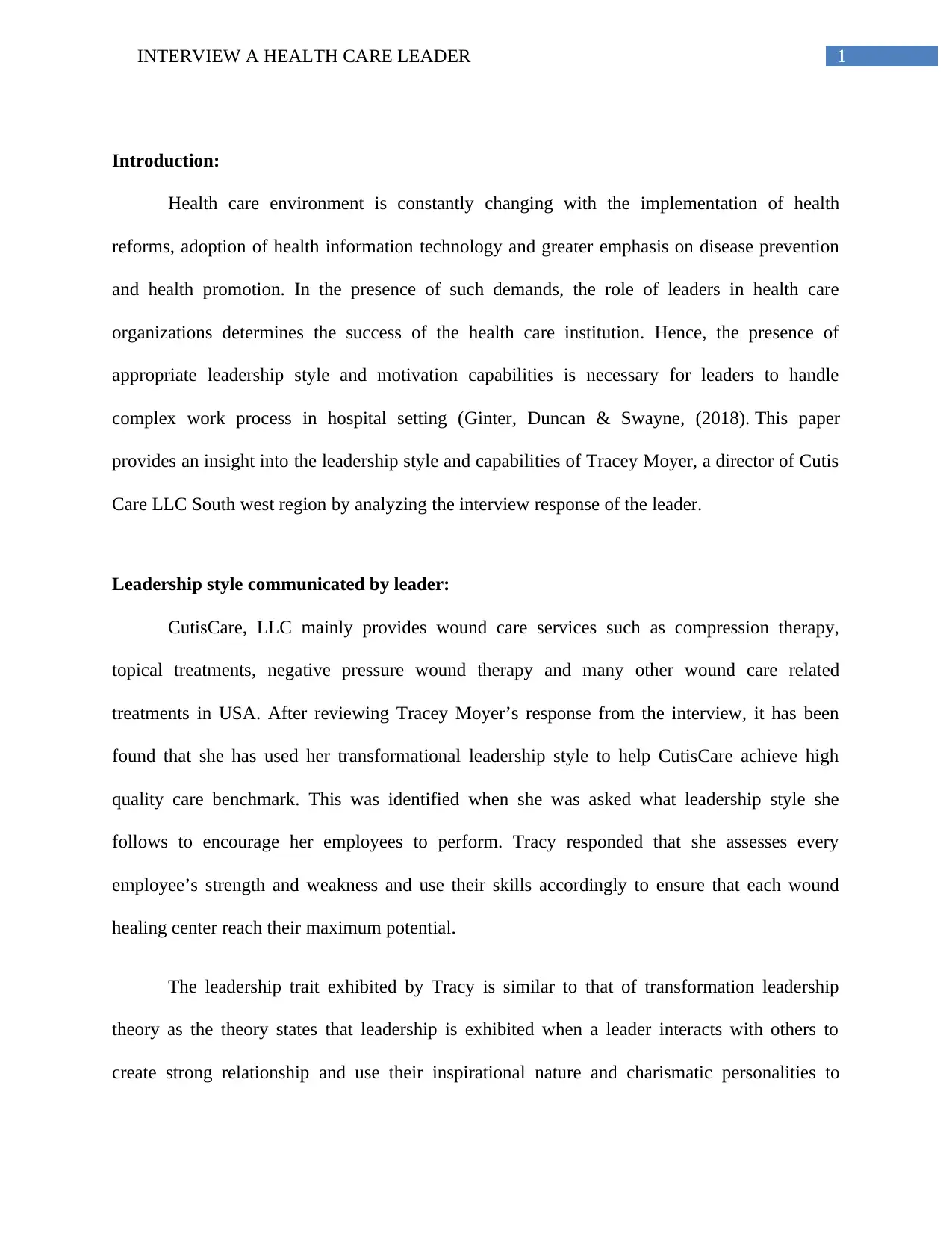
1INTERVIEW A HEALTH CARE LEADER
Introduction:
Health care environment is constantly changing with the implementation of health
reforms, adoption of health information technology and greater emphasis on disease prevention
and health promotion. In the presence of such demands, the role of leaders in health care
organizations determines the success of the health care institution. Hence, the presence of
appropriate leadership style and motivation capabilities is necessary for leaders to handle
complex work process in hospital setting (Ginter, Duncan & Swayne, (2018). This paper
provides an insight into the leadership style and capabilities of Tracey Moyer, a director of Cutis
Care LLC South west region by analyzing the interview response of the leader.
Leadership style communicated by leader:
CutisCare, LLC mainly provides wound care services such as compression therapy,
topical treatments, negative pressure wound therapy and many other wound care related
treatments in USA. After reviewing Tracey Moyer’s response from the interview, it has been
found that she has used her transformational leadership style to help CutisCare achieve high
quality care benchmark. This was identified when she was asked what leadership style she
follows to encourage her employees to perform. Tracy responded that she assesses every
employee’s strength and weakness and use their skills accordingly to ensure that each wound
healing center reach their maximum potential.
The leadership trait exhibited by Tracy is similar to that of transformation leadership
theory as the theory states that leadership is exhibited when a leader interacts with others to
create strong relationship and use their inspirational nature and charismatic personalities to
Introduction:
Health care environment is constantly changing with the implementation of health
reforms, adoption of health information technology and greater emphasis on disease prevention
and health promotion. In the presence of such demands, the role of leaders in health care
organizations determines the success of the health care institution. Hence, the presence of
appropriate leadership style and motivation capabilities is necessary for leaders to handle
complex work process in hospital setting (Ginter, Duncan & Swayne, (2018). This paper
provides an insight into the leadership style and capabilities of Tracey Moyer, a director of Cutis
Care LLC South west region by analyzing the interview response of the leader.
Leadership style communicated by leader:
CutisCare, LLC mainly provides wound care services such as compression therapy,
topical treatments, negative pressure wound therapy and many other wound care related
treatments in USA. After reviewing Tracey Moyer’s response from the interview, it has been
found that she has used her transformational leadership style to help CutisCare achieve high
quality care benchmark. This was identified when she was asked what leadership style she
follows to encourage her employees to perform. Tracy responded that she assesses every
employee’s strength and weakness and use their skills accordingly to ensure that each wound
healing center reach their maximum potential.
The leadership trait exhibited by Tracy is similar to that of transformation leadership
theory as the theory states that leadership is exhibited when a leader interacts with others to
create strong relationship and use their inspirational nature and charismatic personalities to
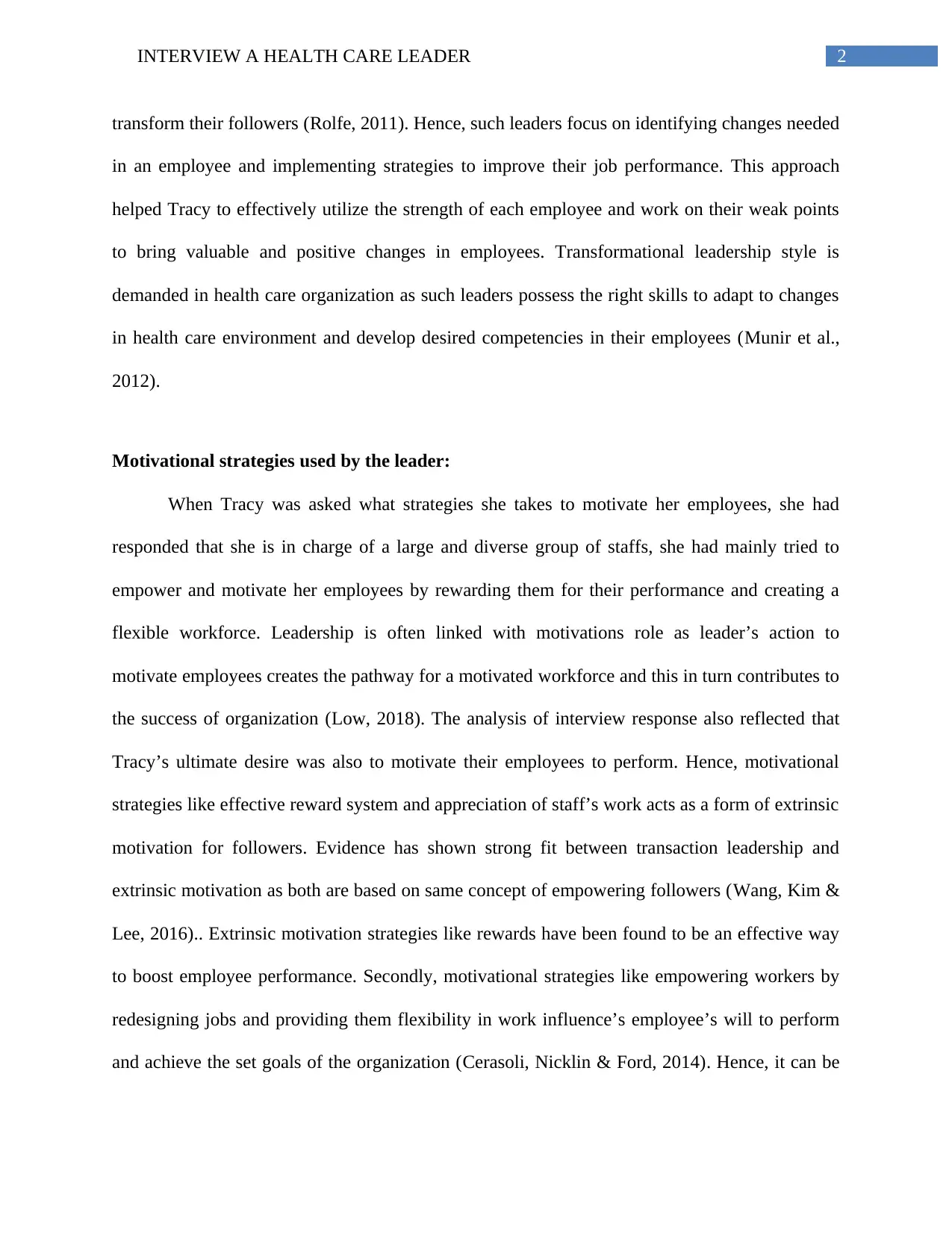
2INTERVIEW A HEALTH CARE LEADER
transform their followers (Rolfe, 2011). Hence, such leaders focus on identifying changes needed
in an employee and implementing strategies to improve their job performance. This approach
helped Tracy to effectively utilize the strength of each employee and work on their weak points
to bring valuable and positive changes in employees. Transformational leadership style is
demanded in health care organization as such leaders possess the right skills to adapt to changes
in health care environment and develop desired competencies in their employees (Munir et al.,
2012).
Motivational strategies used by the leader:
When Tracy was asked what strategies she takes to motivate her employees, she had
responded that she is in charge of a large and diverse group of staffs, she had mainly tried to
empower and motivate her employees by rewarding them for their performance and creating a
flexible workforce. Leadership is often linked with motivations role as leader’s action to
motivate employees creates the pathway for a motivated workforce and this in turn contributes to
the success of organization (Low, 2018). The analysis of interview response also reflected that
Tracy’s ultimate desire was also to motivate their employees to perform. Hence, motivational
strategies like effective reward system and appreciation of staff’s work acts as a form of extrinsic
motivation for followers. Evidence has shown strong fit between transaction leadership and
extrinsic motivation as both are based on same concept of empowering followers (Wang, Kim &
Lee, 2016).. Extrinsic motivation strategies like rewards have been found to be an effective way
to boost employee performance. Secondly, motivational strategies like empowering workers by
redesigning jobs and providing them flexibility in work influence’s employee’s will to perform
and achieve the set goals of the organization (Cerasoli, Nicklin & Ford, 2014). Hence, it can be
transform their followers (Rolfe, 2011). Hence, such leaders focus on identifying changes needed
in an employee and implementing strategies to improve their job performance. This approach
helped Tracy to effectively utilize the strength of each employee and work on their weak points
to bring valuable and positive changes in employees. Transformational leadership style is
demanded in health care organization as such leaders possess the right skills to adapt to changes
in health care environment and develop desired competencies in their employees (Munir et al.,
2012).
Motivational strategies used by the leader:
When Tracy was asked what strategies she takes to motivate her employees, she had
responded that she is in charge of a large and diverse group of staffs, she had mainly tried to
empower and motivate her employees by rewarding them for their performance and creating a
flexible workforce. Leadership is often linked with motivations role as leader’s action to
motivate employees creates the pathway for a motivated workforce and this in turn contributes to
the success of organization (Low, 2018). The analysis of interview response also reflected that
Tracy’s ultimate desire was also to motivate their employees to perform. Hence, motivational
strategies like effective reward system and appreciation of staff’s work acts as a form of extrinsic
motivation for followers. Evidence has shown strong fit between transaction leadership and
extrinsic motivation as both are based on same concept of empowering followers (Wang, Kim &
Lee, 2016).. Extrinsic motivation strategies like rewards have been found to be an effective way
to boost employee performance. Secondly, motivational strategies like empowering workers by
redesigning jobs and providing them flexibility in work influence’s employee’s will to perform
and achieve the set goals of the organization (Cerasoli, Nicklin & Ford, 2014). Hence, it can be
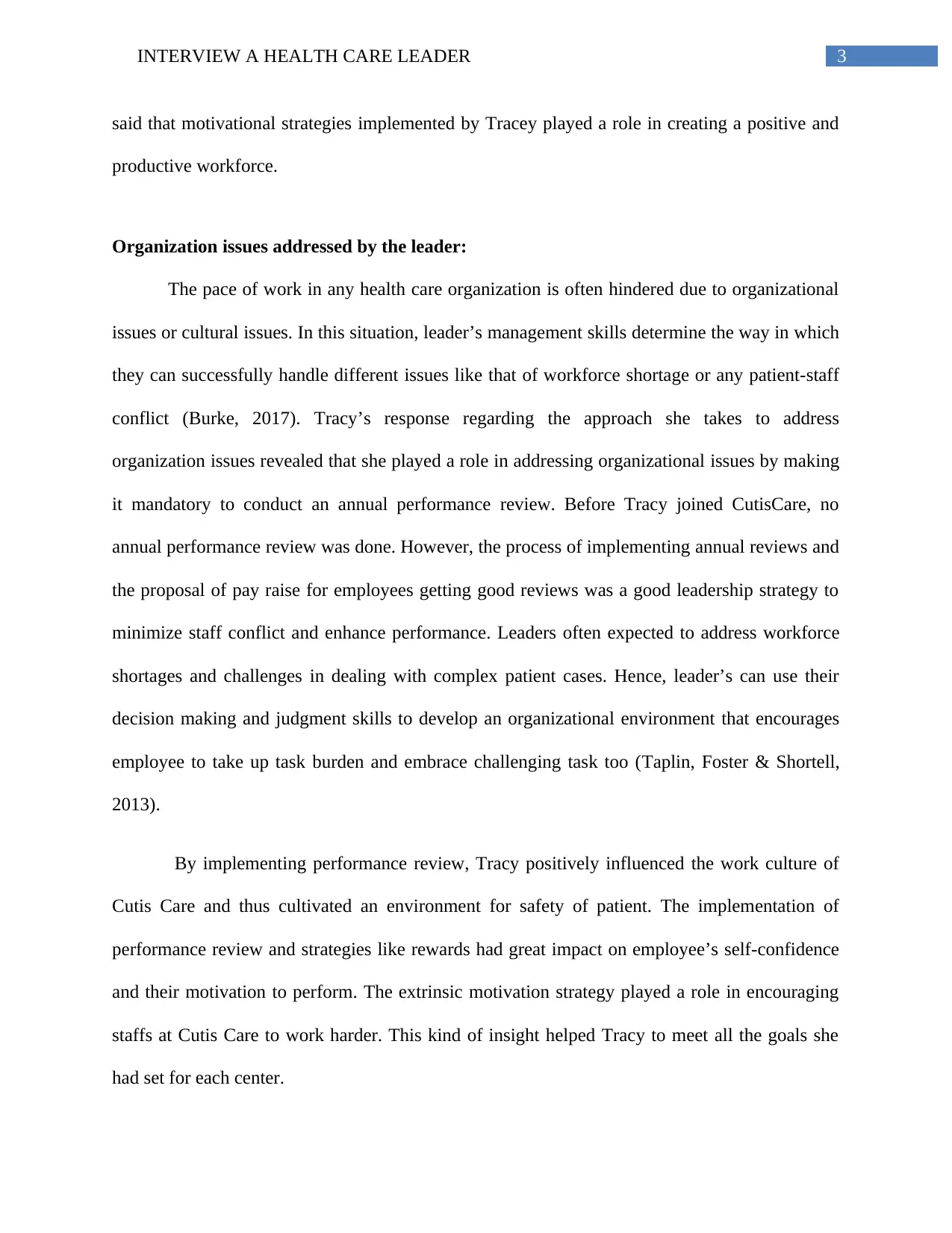
3INTERVIEW A HEALTH CARE LEADER
said that motivational strategies implemented by Tracey played a role in creating a positive and
productive workforce.
Organization issues addressed by the leader:
The pace of work in any health care organization is often hindered due to organizational
issues or cultural issues. In this situation, leader’s management skills determine the way in which
they can successfully handle different issues like that of workforce shortage or any patient-staff
conflict (Burke, 2017). Tracy’s response regarding the approach she takes to address
organization issues revealed that she played a role in addressing organizational issues by making
it mandatory to conduct an annual performance review. Before Tracy joined CutisCare, no
annual performance review was done. However, the process of implementing annual reviews and
the proposal of pay raise for employees getting good reviews was a good leadership strategy to
minimize staff conflict and enhance performance. Leaders often expected to address workforce
shortages and challenges in dealing with complex patient cases. Hence, leader’s can use their
decision making and judgment skills to develop an organizational environment that encourages
employee to take up task burden and embrace challenging task too (Taplin, Foster & Shortell,
2013).
By implementing performance review, Tracy positively influenced the work culture of
Cutis Care and thus cultivated an environment for safety of patient. The implementation of
performance review and strategies like rewards had great impact on employee’s self-confidence
and their motivation to perform. The extrinsic motivation strategy played a role in encouraging
staffs at Cutis Care to work harder. This kind of insight helped Tracy to meet all the goals she
had set for each center.
said that motivational strategies implemented by Tracey played a role in creating a positive and
productive workforce.
Organization issues addressed by the leader:
The pace of work in any health care organization is often hindered due to organizational
issues or cultural issues. In this situation, leader’s management skills determine the way in which
they can successfully handle different issues like that of workforce shortage or any patient-staff
conflict (Burke, 2017). Tracy’s response regarding the approach she takes to address
organization issues revealed that she played a role in addressing organizational issues by making
it mandatory to conduct an annual performance review. Before Tracy joined CutisCare, no
annual performance review was done. However, the process of implementing annual reviews and
the proposal of pay raise for employees getting good reviews was a good leadership strategy to
minimize staff conflict and enhance performance. Leaders often expected to address workforce
shortages and challenges in dealing with complex patient cases. Hence, leader’s can use their
decision making and judgment skills to develop an organizational environment that encourages
employee to take up task burden and embrace challenging task too (Taplin, Foster & Shortell,
2013).
By implementing performance review, Tracy positively influenced the work culture of
Cutis Care and thus cultivated an environment for safety of patient. The implementation of
performance review and strategies like rewards had great impact on employee’s self-confidence
and their motivation to perform. The extrinsic motivation strategy played a role in encouraging
staffs at Cutis Care to work harder. This kind of insight helped Tracy to meet all the goals she
had set for each center.
Secure Best Marks with AI Grader
Need help grading? Try our AI Grader for instant feedback on your assignments.
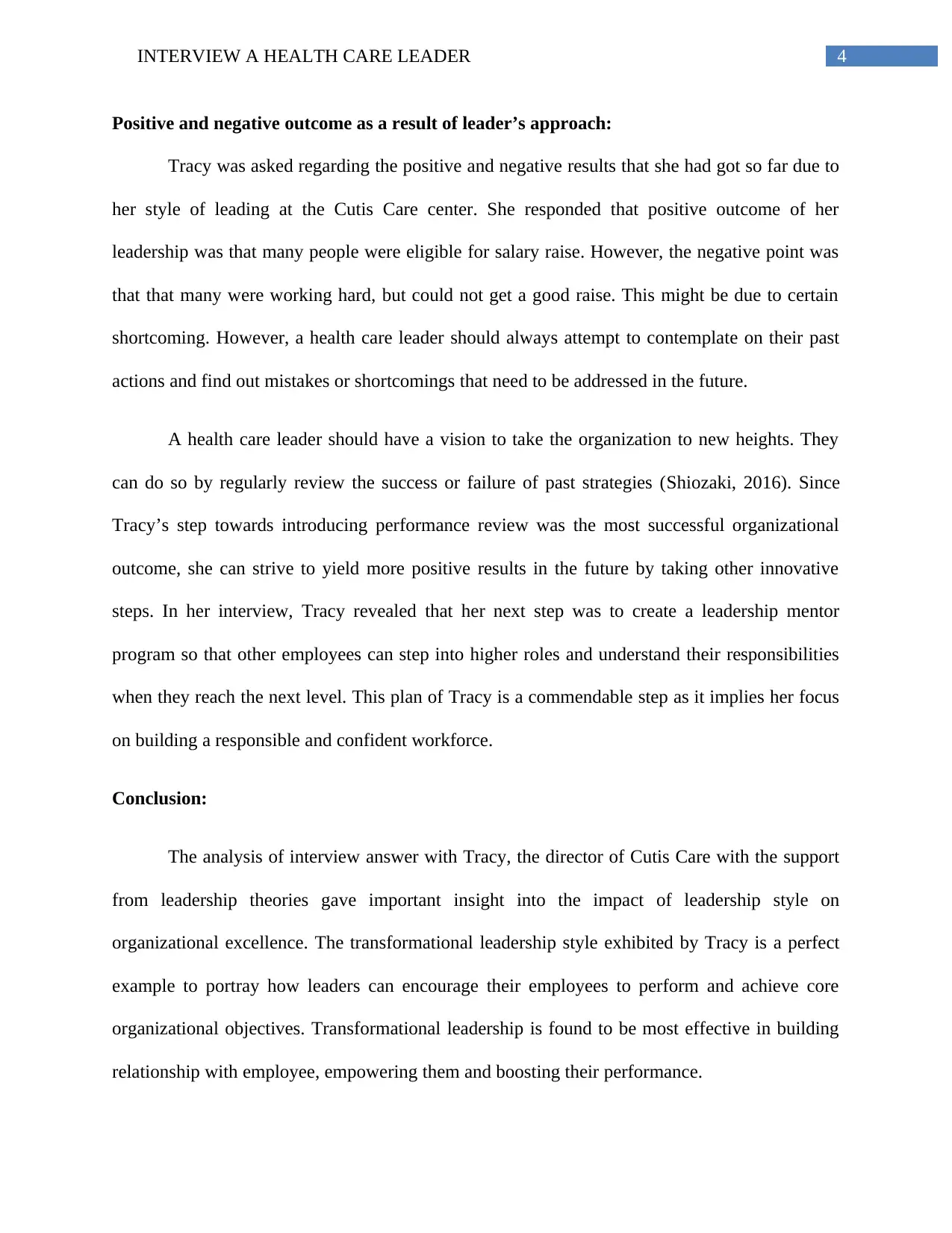
4INTERVIEW A HEALTH CARE LEADER
Positive and negative outcome as a result of leader’s approach:
Tracy was asked regarding the positive and negative results that she had got so far due to
her style of leading at the Cutis Care center. She responded that positive outcome of her
leadership was that many people were eligible for salary raise. However, the negative point was
that that many were working hard, but could not get a good raise. This might be due to certain
shortcoming. However, a health care leader should always attempt to contemplate on their past
actions and find out mistakes or shortcomings that need to be addressed in the future.
A health care leader should have a vision to take the organization to new heights. They
can do so by regularly review the success or failure of past strategies (Shiozaki, 2016). Since
Tracy’s step towards introducing performance review was the most successful organizational
outcome, she can strive to yield more positive results in the future by taking other innovative
steps. In her interview, Tracy revealed that her next step was to create a leadership mentor
program so that other employees can step into higher roles and understand their responsibilities
when they reach the next level. This plan of Tracy is a commendable step as it implies her focus
on building a responsible and confident workforce.
Conclusion:
The analysis of interview answer with Tracy, the director of Cutis Care with the support
from leadership theories gave important insight into the impact of leadership style on
organizational excellence. The transformational leadership style exhibited by Tracy is a perfect
example to portray how leaders can encourage their employees to perform and achieve core
organizational objectives. Transformational leadership is found to be most effective in building
relationship with employee, empowering them and boosting their performance.
Positive and negative outcome as a result of leader’s approach:
Tracy was asked regarding the positive and negative results that she had got so far due to
her style of leading at the Cutis Care center. She responded that positive outcome of her
leadership was that many people were eligible for salary raise. However, the negative point was
that that many were working hard, but could not get a good raise. This might be due to certain
shortcoming. However, a health care leader should always attempt to contemplate on their past
actions and find out mistakes or shortcomings that need to be addressed in the future.
A health care leader should have a vision to take the organization to new heights. They
can do so by regularly review the success or failure of past strategies (Shiozaki, 2016). Since
Tracy’s step towards introducing performance review was the most successful organizational
outcome, she can strive to yield more positive results in the future by taking other innovative
steps. In her interview, Tracy revealed that her next step was to create a leadership mentor
program so that other employees can step into higher roles and understand their responsibilities
when they reach the next level. This plan of Tracy is a commendable step as it implies her focus
on building a responsible and confident workforce.
Conclusion:
The analysis of interview answer with Tracy, the director of Cutis Care with the support
from leadership theories gave important insight into the impact of leadership style on
organizational excellence. The transformational leadership style exhibited by Tracy is a perfect
example to portray how leaders can encourage their employees to perform and achieve core
organizational objectives. Transformational leadership is found to be most effective in building
relationship with employee, empowering them and boosting their performance.
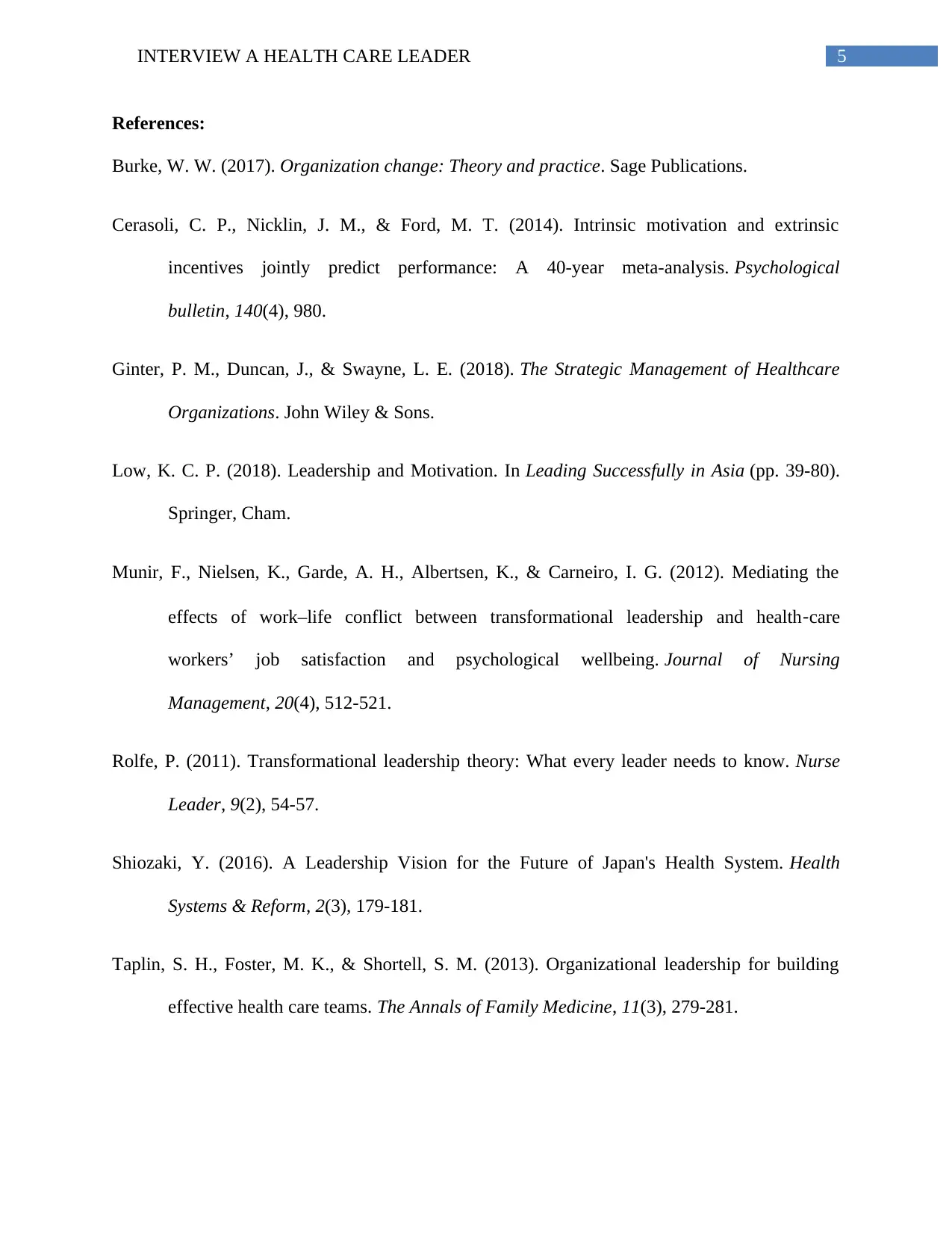
5INTERVIEW A HEALTH CARE LEADER
References:
Burke, W. W. (2017). Organization change: Theory and practice. Sage Publications.
Cerasoli, C. P., Nicklin, J. M., & Ford, M. T. (2014). Intrinsic motivation and extrinsic
incentives jointly predict performance: A 40-year meta-analysis. Psychological
bulletin, 140(4), 980.
Ginter, P. M., Duncan, J., & Swayne, L. E. (2018). The Strategic Management of Healthcare
Organizations. John Wiley & Sons.
Low, K. C. P. (2018). Leadership and Motivation. In Leading Successfully in Asia (pp. 39-80).
Springer, Cham.
Munir, F., Nielsen, K., Garde, A. H., Albertsen, K., & Carneiro, I. G. (2012). Mediating the
effects of work–life conflict between transformational leadership and health‐care
workers’ job satisfaction and psychological wellbeing. Journal of Nursing
Management, 20(4), 512-521.
Rolfe, P. (2011). Transformational leadership theory: What every leader needs to know. Nurse
Leader, 9(2), 54-57.
Shiozaki, Y. (2016). A Leadership Vision for the Future of Japan's Health System. Health
Systems & Reform, 2(3), 179-181.
Taplin, S. H., Foster, M. K., & Shortell, S. M. (2013). Organizational leadership for building
effective health care teams. The Annals of Family Medicine, 11(3), 279-281.
References:
Burke, W. W. (2017). Organization change: Theory and practice. Sage Publications.
Cerasoli, C. P., Nicklin, J. M., & Ford, M. T. (2014). Intrinsic motivation and extrinsic
incentives jointly predict performance: A 40-year meta-analysis. Psychological
bulletin, 140(4), 980.
Ginter, P. M., Duncan, J., & Swayne, L. E. (2018). The Strategic Management of Healthcare
Organizations. John Wiley & Sons.
Low, K. C. P. (2018). Leadership and Motivation. In Leading Successfully in Asia (pp. 39-80).
Springer, Cham.
Munir, F., Nielsen, K., Garde, A. H., Albertsen, K., & Carneiro, I. G. (2012). Mediating the
effects of work–life conflict between transformational leadership and health‐care
workers’ job satisfaction and psychological wellbeing. Journal of Nursing
Management, 20(4), 512-521.
Rolfe, P. (2011). Transformational leadership theory: What every leader needs to know. Nurse
Leader, 9(2), 54-57.
Shiozaki, Y. (2016). A Leadership Vision for the Future of Japan's Health System. Health
Systems & Reform, 2(3), 179-181.
Taplin, S. H., Foster, M. K., & Shortell, S. M. (2013). Organizational leadership for building
effective health care teams. The Annals of Family Medicine, 11(3), 279-281.
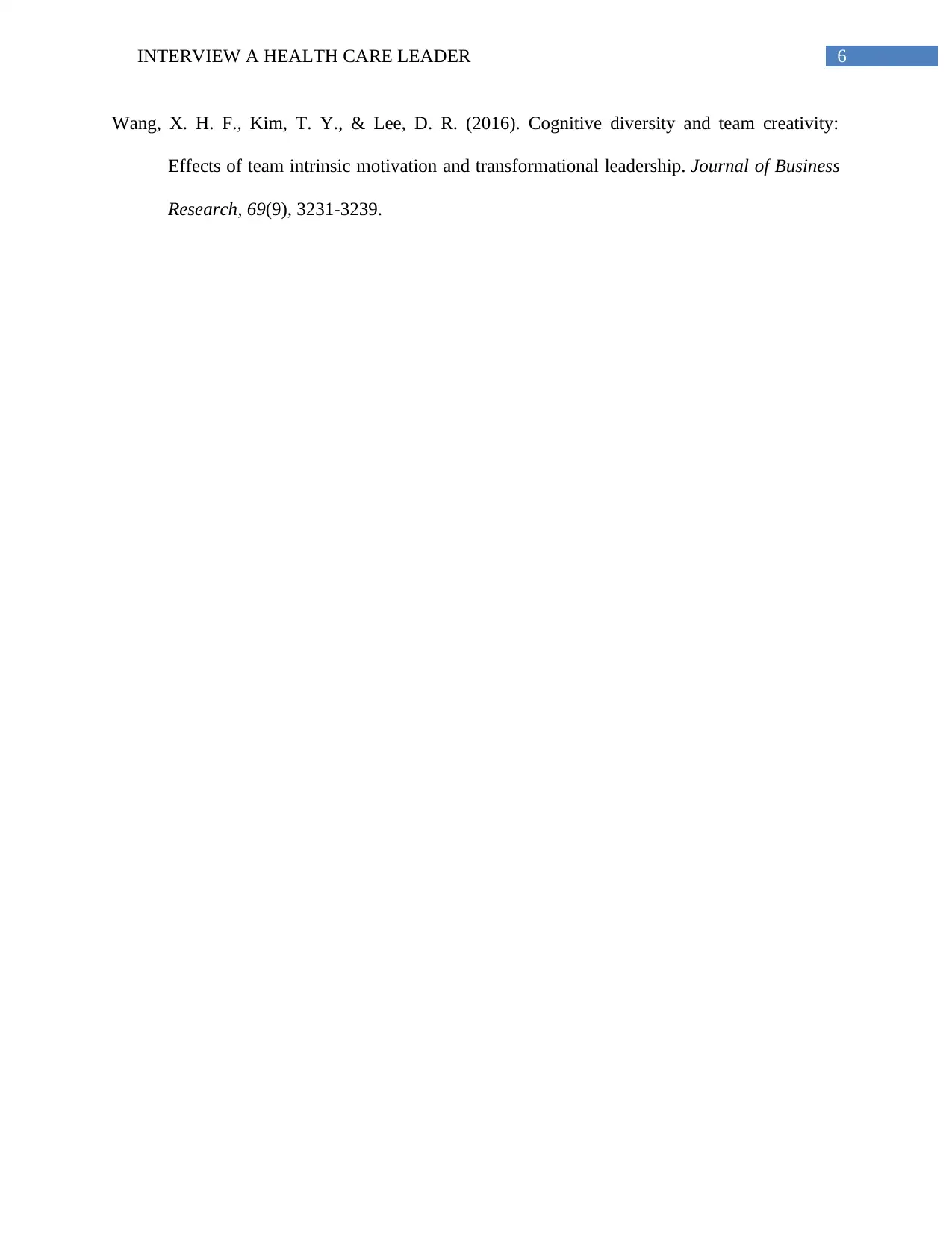
6INTERVIEW A HEALTH CARE LEADER
Wang, X. H. F., Kim, T. Y., & Lee, D. R. (2016). Cognitive diversity and team creativity:
Effects of team intrinsic motivation and transformational leadership. Journal of Business
Research, 69(9), 3231-3239.
Wang, X. H. F., Kim, T. Y., & Lee, D. R. (2016). Cognitive diversity and team creativity:
Effects of team intrinsic motivation and transformational leadership. Journal of Business
Research, 69(9), 3231-3239.
1 out of 7
Related Documents
Your All-in-One AI-Powered Toolkit for Academic Success.
+13062052269
info@desklib.com
Available 24*7 on WhatsApp / Email
![[object Object]](/_next/static/media/star-bottom.7253800d.svg)
Unlock your academic potential
© 2024 | Zucol Services PVT LTD | All rights reserved.





